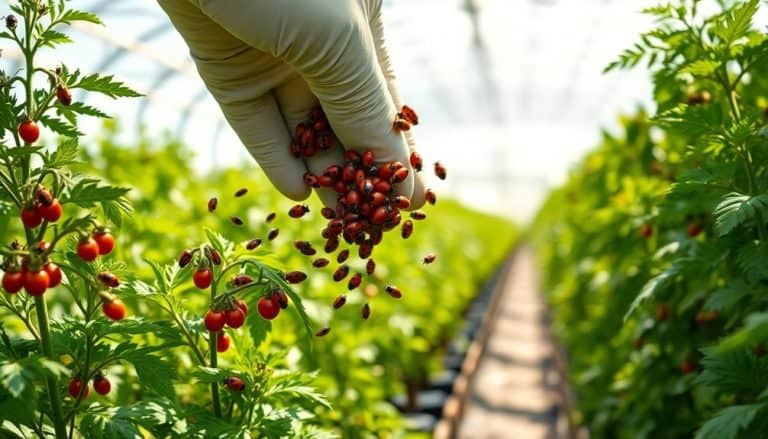This website contains affiliate links. Some products are gifted by the brand to test. As an Amazon Associate, I earn from qualifying purchases. The content on this website was created with the help of AI.
You’ll need to focus on five core maintenance areas for greenhouse success: environmental control, structural integrity, plant health, irrigation, and sanitation. Maintain ideal temperature (70-85°F) and humidity (50-70%) while ensuring proper ventilation through regular system checks. Conduct weekly structural inspections of joints, glazing, and foundations to prevent deterioration. Monitor plant health daily for disease and pest issues, implementing integrated pest management strategies. Keep irrigation systems clean and calibrated, checking components weekly for proper function. Master these essential tasks, and your greenhouse operation will reveal increasingly sophisticated management opportunities.
Key Takeaways
- Monitor and maintain temperature between 70-85°F and humidity between 50-70% using ventilation systems and environmental controls.
- Perform regular structural inspections of joints, glazing, and foundations to identify and address potential issues early.
- Implement daily plant health monitoring routines to detect diseases, pests, and nutritional deficiencies before they become severe.
- Check irrigation systems weekly for clogs and leaks, while maintaining proper water pressure between 20-50 PSI.
- Follow a structured cleaning schedule with daily debris removal and weekly sanitization of surfaces using appropriate disinfectants.
Daily Temperature and Humidity Control
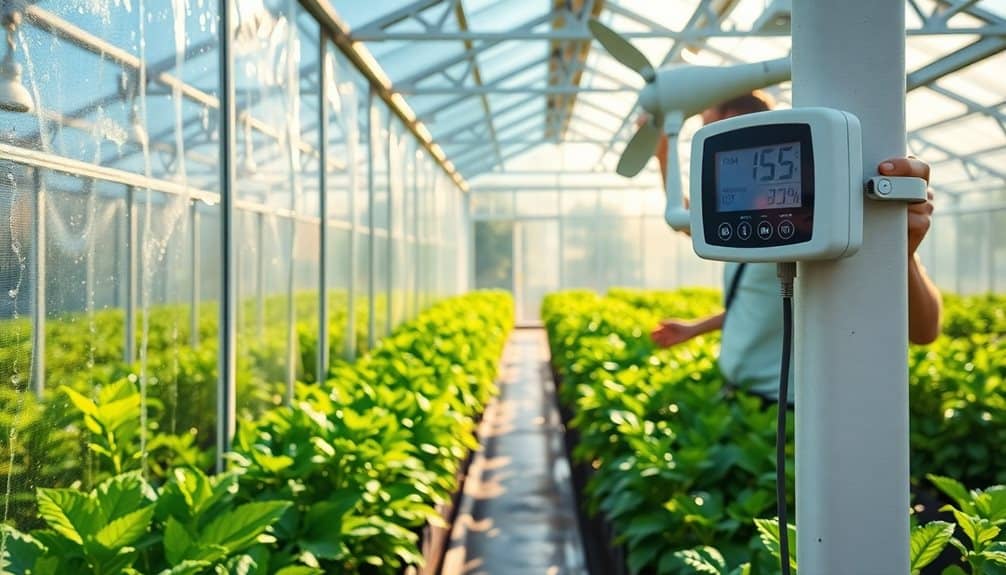
Three critical environmental factors – temperature, relative humidity, and vapor pressure deficit (VPD) – must be monitored and adjusted daily to maintain ideal growing conditions in your greenhouse. You’ll need to measure these parameters using calibrated sensors during morning, midday, and evening periods to guarantee peak plant health.
Maintain daytime temperatures between 70-85°F (21-29°C) for most crops, with a 10-15°F night temperature reduction to support proper metabolic functions. You’ll want to control relative humidity between 50-70% to prevent both fungal diseases and transpiration stress. Calculate your VPD values to stay within 0.8-1.2 kPa during vegetative growth and 1.0-1.5 kPa during flowering stages.
To achieve these targets, you’ll need to operate ventilation systems, shade cloth, or evaporative cooling during high-temperature periods. Deploy horizontal air flow fans to maintain consistent air circulation and prevent microclimatic variations. You can regulate humidity through strategic timing of irrigation, proper plant spacing, and dehumidification equipment when necessary. Record daily measurements in a monitoring log to track patterns and adjust your environmental control strategies accordingly. Installing a smart controller system can help automate these environmental adjustments while reducing manual monitoring requirements.
Ventilation System Maintenance
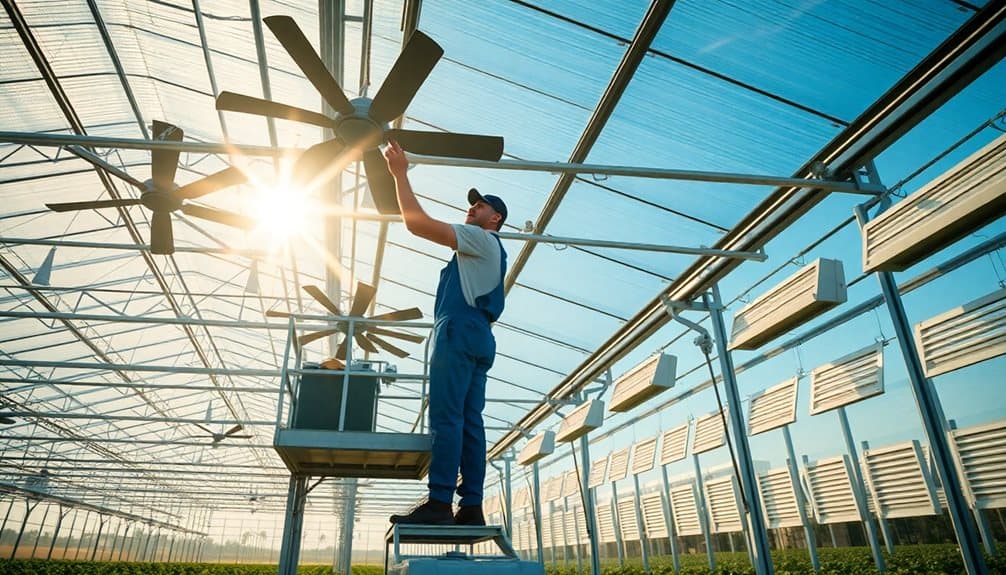
Maintaining your greenhouse ventilation system requires weekly inspections and regular cleaning to confirm ideal airflow performance. A well-functioning ventilation system prevents pathogen buildup, regulates temperature, and guarantees proper gas exchange for photosynthesis. You’ll need to check all mechanical components, including fans, louvers, and automated vent controls, for signs of wear or malfunction. Automatic vent controls can significantly maximize your garden’s growing potential through precise temperature regulation.
To keep your ventilation system operating at peak efficiency:
- Clean fan blades, guards, and exhaust ports monthly using a biodegradable degreaser to remove dust, pollen, and mineral deposits that can reduce airflow capacity by up to 30%
- Lubricate all moving parts quarterly with food-grade silicon spray, paying special attention to vent arms, fan motors, and gear mechanisms
- Test thermostat controls and calibrate sensors bi-annually to confirm accurate temperature-dependent responses
Don’t forget to inspect screening materials for tears or gaps that could allow pest entry. Replace damaged screens immediately using appropriate mesh sizes: 50-mesh for thrips protection or 32-mesh for general insect exclusion. When cleaning, always disconnect power sources and follow manufacturer specifications for maintenance procedures to extend equipment life and maintain warranty validity.
Cleaning and Sanitizing Protocols

A rigorous cleaning and sanitization program forms the backbone of successful greenhouse operations, complementing proper ventilation practices. You’ll need to implement a three-phase approach: daily surface cleaning, weekly deep cleaning, and monthly sterilization protocols. Remove plant debris, fallen leaves, and dead material daily to prevent pathogen proliferation.
For weekly cleaning, you’ll want to sanitize all work surfaces, tools, and containers with a quaternary ammonium solution or 10% bleach mixture. Don’t forget to disinfect irrigation lines and nozzles to prevent algal growth and mineral buildup. Pay special attention to corners, joints, and areas beneath benches where pathogens often accumulate.
During monthly sterilization, you’ll need to thoroughly clean greenhouse glazing, structural components, and floor surfaces. Apply broad-spectrum disinfectants using a fogger or sprayer, ensuring complete coverage of all surfaces. It is crucial to maintain detailed sanitation logs and rotate between different sanitizing agents to prevent pathogen resistance. Remember to calibrate solution concentrations precisely – too weak won’t be effective, while too strong can damage plants and equipment. Maintaining proper temperature control systems throughout the cleaning process helps ensure optimal effectiveness of sanitizing agents and prevents condensation issues that could compromise cleanliness.
Pest Management Strategies

Effective pest management in greenhouses requires an integrated approach combining biological controls, cultural practices, and targeted chemical interventions. You’ll need to regularly monitor plant health and maintain detailed records of pest populations to implement timely control measures. Early detection through weekly inspections of leaf surfaces, growing media, and structural components is essential for preventing widespread infestations.
Implement these vital pest management protocols:
- Deploy beneficial insects such as Encarsia formosa for whitefly control, Phytoseiulus persimilis for spider mites, and Aphidius colemani for aphid suppression, maintaining ideal temperature and humidity levels for their effectiveness.
- Install physical barriers including insect screening (minimum 50-mesh), sticky traps, and proper air circulation systems to reduce pest entry points and movement within the greenhouse environment.
- Apply selective pesticides only when necessary, rotating between different modes of action to prevent resistance development, and adhering to strict application protocols during non-peak pollinator activity periods.
You’ll find that maintaining proper plant spacing, managing relative humidity, and removing plant debris promptly will greatly reduce pest pressure and the need for chemical interventions. For lasting protection against common greenhouse pests, consider implementing natural control solutions that are both environmentally friendly and cost-effective.
Irrigation System Care

Regular inspection and maintenance of your greenhouse irrigation system guarantees excellent water distribution and prevents costly plant stress or loss. You’ll need to check sprinkler heads, drip emitters, and distribution lines weekly for clogs, leaks, or irregular spray patterns. Clean or replace filters monthly to prevent sediment buildup and maintain consistent water flow.
Test your system’s pressure regularly using a water pressure gauge at various points along the irrigation lines. You should maintain pressure between 20-50 PSI for most greenhouse applications. Inspect electronic controllers and timers for accurate scheduling, and calibrate soil moisture sensors every three months to ensure proper readings.
Flush your irrigation lines quarterly with a diluted hydrogen peroxide solution (1:100 ratio) to eliminate biofilm and mineral deposits. Don’t forget to check backflow preventers and vacuum breakers annually for proper function. Replace worn gaskets and seals immediately to prevent water waste. During winter, drain all lines thoroughly if there’s freeze risk, and insulate exposed pipes with foam sleeves. Monitor water pH and EC levels weekly, adjusting your injection system as needed to maintain ideal growing conditions. Using high-quality UV tubing in your irrigation setup will significantly extend system longevity and reduce maintenance needs over time.
Structural Inspection and Repairs
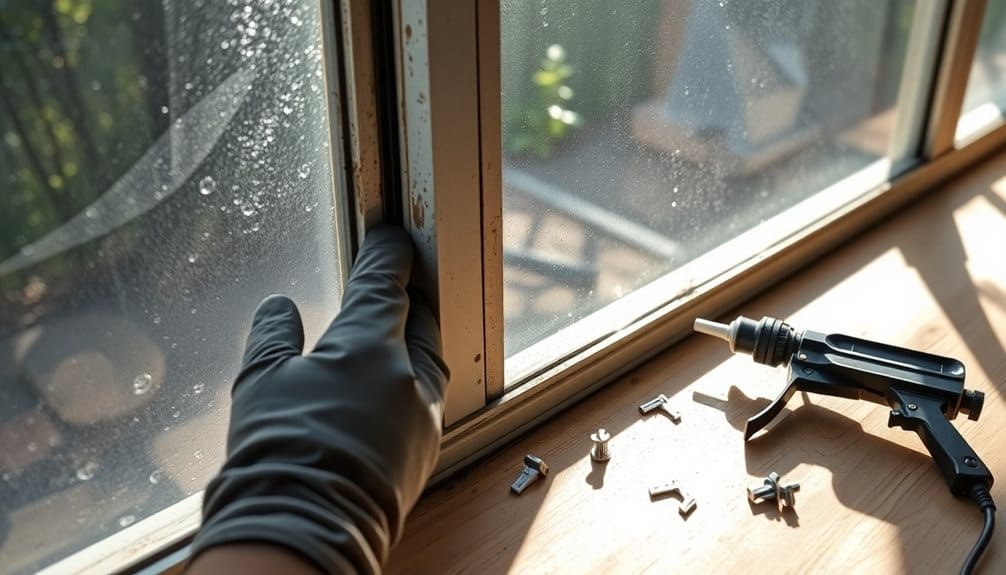
Three critical structural components of your greenhouse require systematic inspection: the frame integrity, panel condition, and foundation stability. You’ll need to conduct thorough examinations quarterly, with additional checks after severe weather events. Document any signs of deterioration, corrosion, or stress points that could compromise the structure’s integrity.
- Frame Inspection: Examine all joints, connections, and support beams for rust, loose bolts, or metal fatigue. Check load-bearing points where trusses meet vertical supports, and guarantee proper alignment of all structural members. Apply rust-inhibiting compounds to metal surfaces showing early oxidation.
- Panel Assessment: Inspect glazing materials for cracks, UV degradation, or separation from fasteners. Check rubber gaskets and seals for brittleness or compression failure. Monitor panel overlap areas for water infiltration or debris accumulation.
- Foundation Evaluation: Assess concrete footings for cracks, settling, or frost heave damage. Verify drainage patterns around the foundation perimeter, and guarantee proper ground contact maintenance. Test anchor points where the frame connects to the foundation.
Address minor repairs immediately to prevent escalation into major structural issues that could compromise your greenhouse’s environmental stability and plant protection capabilities.
Plant Health Monitoring
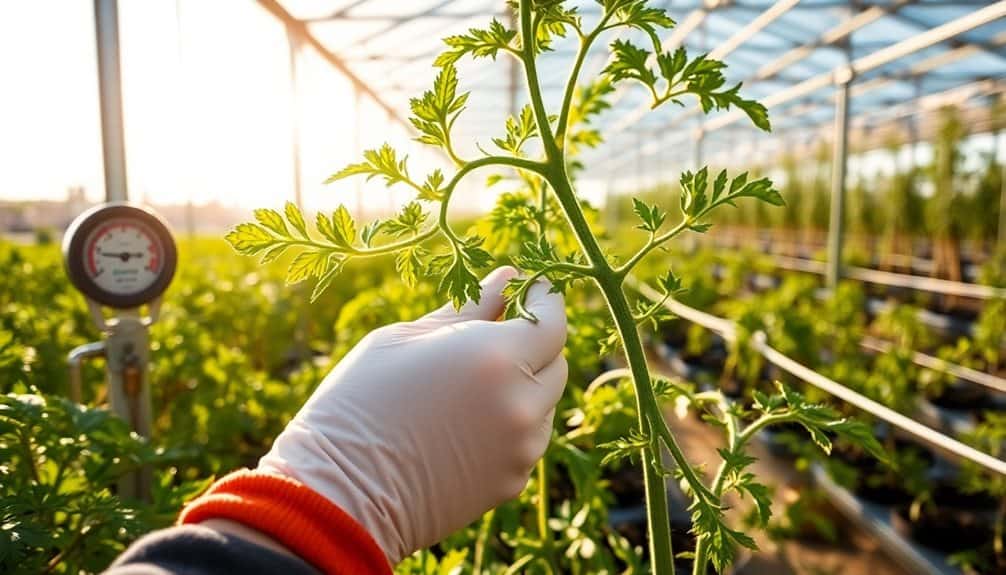
Maintaining vigilant plant health surveillance forms the cornerstone of successful greenhouse operations. You’ll need to implement systematic monitoring protocols to detect early signs of disease, pest infestations, or nutritional deficiencies. Monitor leaf coloration, stem integrity, and root health through daily visual inspections of your plant specimens.
Record key crucial signs including chlorophyll levels using a SPAD meter, measuring stomatal conductance, and tracking plant growth rates. You’ll want to examine the undersides of leaves for spider mites, whiteflies, or aphid colonies, while also checking for fungal lesions or bacterial spots. Monitor substrate moisture levels using calibrated sensors and maintain detailed records of pH and EC measurements.
Establish quarantine protocols for new plant materials and conduct weekly disease screening. You should analyze tissue samples when symptoms appear unclear and maintain detailed documentation of all observations. If you notice declining plant vigor, perform immediate diagnostic tests to identify causal agents. By implementing these monitoring procedures, you’ll create an early warning system that enables rapid intervention before plant health issues become severe.
Seasonal Equipment Adjustments
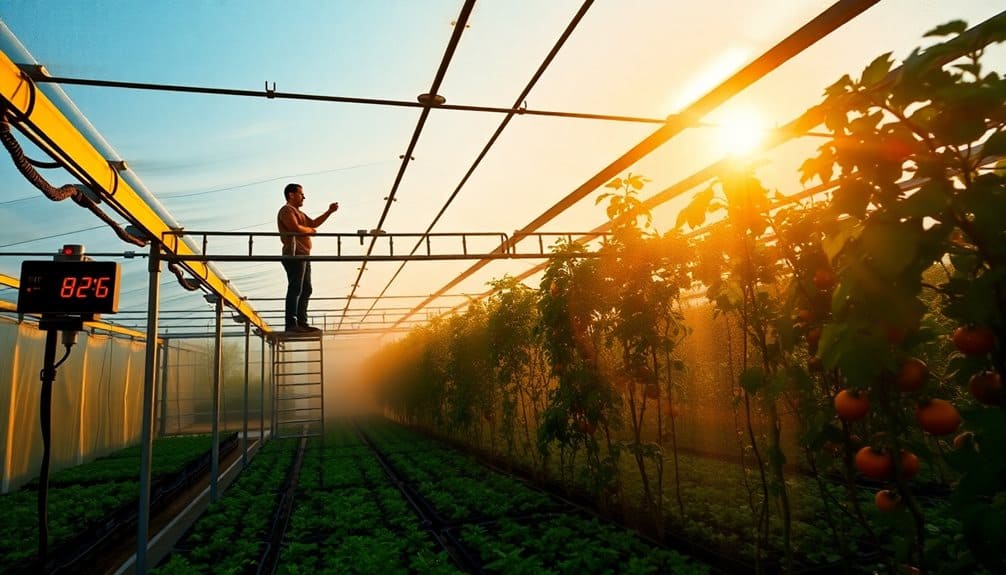
Greenhouse equipment calibration requires systematic adjustments throughout the year to maintain ideal growing conditions. You’ll need to modify ventilation systems, heating elements, and irrigation equipment based on seasonal temperature fluctuations and changing daylight hours.
Your primary focus should be on these critical seasonal modifications:
- During spring changeover, recalibrate your automated vent systems to operate at lower temperature thresholds (typically 75-80°F), adjust shade cloth deployment timing, and increase humidity control measures to compensate for rising external temperatures.
- For summer operations, maximize cooling efficiency by setting exhaust fans to activate in staged sequences, adjusting evaporative cooling pads’ water flow rates, and modifying irrigation frequency based on increased evapotranspiration rates.
- In fall and winter preparation, reconfigure heating systems to maintain minimum night temperatures (usually 55-65°F), adjust supplemental lighting timers to compensate for shorter days, and reset irrigation volumes to account for reduced water requirements.
You’ll also need to verify sensor calibration quarterly, ensuring your environmental control systems respond accurately to changing conditions. Document all adjustments in your maintenance log for future reference and troubleshooting.
Frequently Asked Questions
How Much Does It Cost to Build a Basic Greenhouse?
You’ll find basic greenhouse costs ranging from $500 to $3,000, like choosing between budget-friendly polycarbonate panels or premium glass panes. A DIY 8×10-foot structure with PVC framing and polyethylene covering costs around $500-800, while prefabricated kits of similar size run $1,000-2,000. For durability, aluminum-framed models with twin-wall polycarbonate start at $2,000, offering ideal light diffusion and thermal efficiency.
Can I Convert My Existing Patio Into a Greenhouse?
You can convert your patio into a greenhouse through strategic enclosure methods. Install polycarbonate or tempered glass panels on a frame system attached to existing posts or walls. You’ll need proper ventilation systems, including roof vents and possibly automated fans. Consider the patio’s structural integrity, load-bearing capacity, and drainage requirements. Guarantee adequate light transmission and maintain appropriate temperature control through thermal mass solutions.
What Permits Do I Need to Construct a Greenhouse?
You’ll need to check with your local municipality’s building department for specific permit requirements, as they vary by location. Typically, you’ll require a building permit for permanent greenhouse structures larger than 120 square feet. Additional permits might include zoning permits, structural engineering approval, and electrical permits if you’re installing climate control systems. HOA approval may also be necessary in residential developments.
Which Greenhouse Covering Material Lasts the Longest?
Among greenhouse covering materials, polycarbonate panels offer the longest lifespan, lasting 15-20 years with proper maintenance. You’ll find twin-wall or triple-wall polycarbonate provides superior durability against UV damage, impacts, and extreme weather conditions. While glass can last indefinitely, it’s more susceptible to breakage. Polyethylene films typically last 3-5 years, and acrylic panels have a 10-15 year lifespan under ideal conditions.
Should I Choose a Freestanding or Lean-To Greenhouse Design?
Your choice between freestanding and lean-to designs depends on several key factors. Freestanding greenhouses offer superior ventilation, maximum light exposure, and flexible crop arrangement due to 360-degree access. Lean-to structures, while utilizing existing wall thermal mass and requiring less space, typically provide reduced growing area and limited ventilation. If you’ve got adequate space and prioritize ideal growing conditions, choose freestanding. Select lean-to when space is limited.


